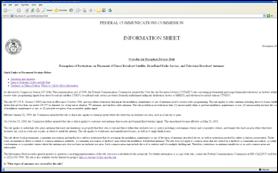Federal Communications Commission Information Sheet
Over-the-Air Reception Devices Rule
 As directed by Congress in Section 207 of the Telecommunications Act of 1996, the Federal Communications Commission adopted the Over-the-Air Reception Devices (“OTARD”) rule concerning governmental and nongovernmental restrictions on viewers' ability to receive video programming signals from direct broadcast satellites ("DBS"), broadband radio service providers (formerly multichannel multipoint distribution service or MMDS), and television broadcast stations ("TVBS").
As directed by Congress in Section 207 of the Telecommunications Act of 1996, the Federal Communications Commission adopted the Over-the-Air Reception Devices (“OTARD”) rule concerning governmental and nongovernmental restrictions on viewers' ability to receive video programming signals from direct broadcast satellites ("DBS"), broadband radio service providers (formerly multichannel multipoint distribution service or MMDS), and television broadcast stations ("TVBS").
The rule (47 C.F.R. Section 1.4000) has been in effect since October 1996, and it prohibits restrictions that impair the installation, maintenance or use of antennas used to receive video programming. The rule applies to video antennas including direct-to-home satellite dishes that are less than one meter (39.37") in diameter (or of any size in Alaska), TV antennas, and wireless cable antennas. The rule prohibits most restrictions that: (1) unreasonably delay or prevent installation, maintenance or use; (2) unreasonably increase the cost of installation, maintenance or use; or (3) preclude reception of an acceptable quality signal.
Effective January 22, 1999, the Commission amended the rule so that it also applies to rental property where the renter has an exclusive use area, such as a balcony or patio.
On October 25, 2000, the Commission further amended the rule so that it applies to customer-end antennas that receive and transmit fixed wireless signals. This amendment became effective on May 25, 2001.
The rule applies to individuals who place antennas that meet size limitations on property that they own or rent and that is within their exclusive use or control, including condominium owners and cooperative owners, and tenants who have an area where they have exclusive use, such as a balcony or patio, in which to install the antenna. The rule applies to townhomes and manufactured homes, as well as to single family homes.
The rule allows local governments, community associations and landlords to enforce restrictions that do not impair the installation, maintenance or use of the types of antennas described above, as well as restrictions needed for safety or historic preservation. Under some circumstances where a central or common antenna is available, a community association or landlord may restrict the installation of individual antennas. The rule does not apply to common areas that are owned by a landlord, a community association, or jointly by condominium or cooperative owners where the antenna user does not have an exclusive use area. Such common areas may include the roof or exterior wall of a multiple dwelling unit. Therefore, restrictions on antennas installed in or on such common areas are enforceable.
This Information Sheet provides general answers to questions concerning implementation of the rule, but is not a substitute for the actual rule. For further information or a copy of the rule, contact the Federal Communications Commission at 888-CALLFCC (toll free) or (202) 418-7096.